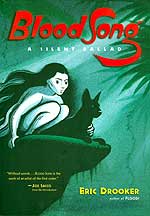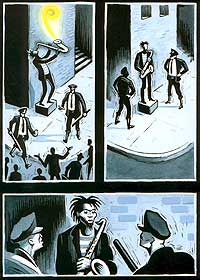
|
Ten years after his first book, "Flood!," appeared and won an American Book Award, Drooker has released a kind of follow-up, "Blood Song" (Harcourt, Inc.; 300 pp.; $20). (A new edition of "Flood!" is being concurrently released by Dark Horse Comics.) Both "Flood!" and "Blood Song" continue Masereel's idea of a silent journey. But where "Flood!" took place exclusively in the dehumanizing world of a biblically punished New York, "Blood Song," moves from a pastoral to a modern metropolis, exploring the role of the individual in nature and society.
I made the mistake of reading "Blood Song" before noticing the sub-title, "A Silent Ballad." That is, I read it like a graphic novel, with a novel-reader's interest in character and story. In this manner I consumed this epic work within fifteen minutes and felt gypped. Seemingly naive and simplistic, the story tells of a young woman living peacefully with her family in what looks like Vietnam. One day soldiers arrive (conspicuously similar to American G.I.s) and destroy the village. She flees through the jungle and across the sea. She arrives at a modern city with dark, bedraggled citizens under constant surveillance. She meets a street musician, who after being arrested by the fascist police force, leaves her with child. At the end, the cry of the newborn continues the father's song.
 A two-page diptych from "Blood Song"
A two-page diptych from "Blood Song" |
But taken as a ballad — a narrative poem — "Blood Song" becomes beautiful and expansive. Like a ballad, its story exits only as a thread for the reader to follow through the metaphors and themes. One way of reading it, for example, is a story about the transition from child to adult — moving from careless tranquility through tempestuous seas to the world of responsibility and childbirth.
Other meanings emerge when reading "Blood Song" with a more poetic sense. The two big themes of Eric Drooker's work have always been the individual vs. the state and nature vs. technology. (He even overlays animals on the UPC code of his books.) In "Blood Song," often these themes will overlap as when the young woman flees the police. The chase transforms into an ecstatic dance amid traffic lights, parking meters and pedestrians. Her skeleton becomes visible through her skin, juxtaposing her corporeal self against the unnatural trapping of a metropolis.
 The Musician gets harrased
The Musician gets harrased |
Of course, as a ballad, you also read "Blood Song" as much for the way it tells the story as for the story itself. With a traditional ballad you may notice the rhyme scheme or alliteration. Here you marvel at Drooker's skill as an artist. Reminiscent of Masereel's woodcuts, Drooker uses scratchboard, where you carve out the lines rather than draw them in. Over this he adds layers of slate-gray watercolor for tone and depth. Then, amidst this near-monochrome world, at sparingly particular moments, he adds a zap of color: a bird, a butterfly, or blood. It's a transcendent effect. The meter of the poem comes from the layout. Most pages are diptychs, with both sides of the book working as individual panels that form a larger image. Never one to dull the eye, Drooker occasionally breaks these up into smaller panels, most noticeably as the woman gets lost in the confinement of the city.
Eric Drooker's elegiac, spiritual, and political "Blood Song" has no current peer. Written in a language that anyone can understand, exploring themes of universal interest, Drooker continues Masereel's profoundly democratic artwork.
"Blood Work" can be found at regular bookstores and smarter comic stores
